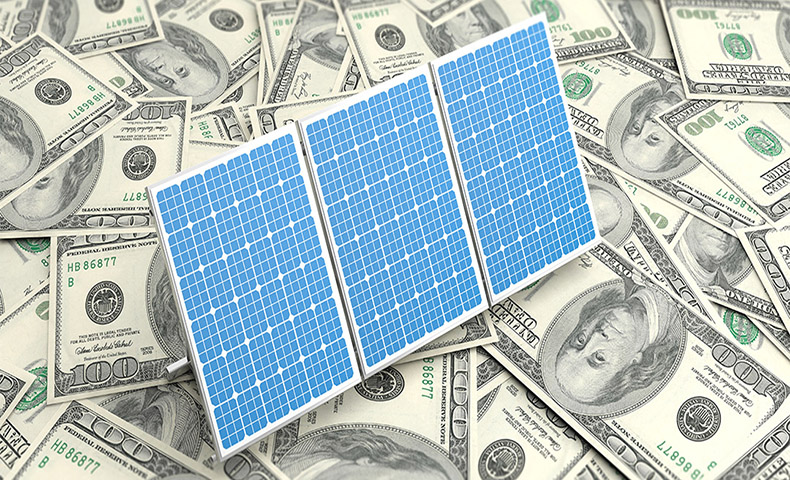
After scientists at Bell Labs in New Jersey unveiled the first working solar cell in 1954, the technology was helped in great part by the “space decade” of the 1960s, when the space industry began to use it to provide solar power aboard their spacecraft. The Vanguard 1 was the first artificial Earth satellite powered by solar cells and remains the oldest man-made satellite in orbit – logging more than 6 billion miles.
The energy crisis of the 1970s brought this technology closer to Earth. But it was still too expensive for the majority of homeowners to even consider installing a home solar power system. In fact, the typical price of a solar panel in 1975 was about 227 times higher than it is today at $101.5/watt versus $0.447/watt.
The price of solar energy is now making it easy and affordable for just about anyone to get a home solar power system, which is fueling the rapid expansion of the industry.
A photovoltaic (PV) home solar power system is installed every four minutes.
That popularity is also backed by an array of solar incentives at the federal, state and local levels that help reduce the initial price of a domestic home solar power system even further, which includes solar energy tax benefits.
Here’s a breakdown of some of these programs and you can take advantage of them.
Solar Investment Tax Credit (ITC)
Don’t ever say the federal government doesn’t give you anything! This is a biggie as it allows you to take a 30% credit on the cost of your solar equipment and the cost of solar installation, but only through 2019. The ITC has been available since 2005, but next year (unless Congress passes an exemption, which at this point is not likely) it will begin to drop to 26% before moving down further to 22% in 2021 and then disappearing completely after that.
The ITC is a solar energy tax benefit that is also available to the commercial, industrial, utility, and agricultural sectors, that will still be able to get a permanent 10% credit even after it phases out for homeowners.
Just to clarify, this is not a deduction, but a solar power energy credit you can take against money owed to the government, but it can be substantial.
This form of solar energy tax benefits has motivated many homeowners and businesses to install solar sooner rather than later. There is even speculation that the phase down will further push more people to install solar panels, meaning solar installers will be very busy in the second part of this year.
Accelerated Depreciation Bonus
For business, under this federal solar incentive, the cost of the system can be fully depreciated in the first year. Considering the new corporate tax rate, this means the federal government offers to cover up to 21 percent of a solar system’s cost with this depreciation.
The bonus came as in response to the economic downturn of 2008 when Congress took action to further solar incentives capital investment by accelerating the depreciation schedule economy-wide, explains the Solar Energy Industries Association (SEIA).
Under the law, businesses1 may claim 100% bonus depreciation on what the rules now define as “qualified property.” Property that is acquired and placed in service after Sept. 27, 2017, and before Jan. 1, 2023.

Solar Renewable Energy Credits (SRECs)
Businesses and homeowners can also generate a revenue stream from solar by actively trading solar power energy credits. These are certificates for energy that they can sell to the utility. SRECs behave like stock certificates and are bought and sold on a dedicated market. The SREC market varies from state to state, so look up the state that offers it at www.srectrade.com.
The SREC is sold separately from the solar electricity and represents the "solar" aspect of the solar electricity that was produced. The value of an SREC is determined by the market subject to supply and demand constraints. In general terms, 1 SREC is equal to 1 kWh of solar electricity. A 10 kW facility generates around 12 SRECs annually.
Net Metering
With net metering, businesses and homeowners can sell excess solar electricity to their utility company in exchange for credits towards the next bill for the power they get from the grid when the solar panels aren’t generating any power.
In order to take full advantage of this, your solar installer needs to make a detailed evaluation of your annual and monthly energy needs and have a solar power system match that.
To find the appropriate size of solar array for your home or business, simply access the Hahasmart price checker. Provide your address and monthly electric costs and you will get an estimated price of the panels and inverter - the most expensive parts of a solar energy system. They’ll also provide you with an estimate for the cost of installation based on thousands of completed solar projects in your area. All you have to do is provide your address and your average monthly utility bill.
They’ll even provide you with an estimated buyback period, the point where the solar electricity savings cover the purchase of your home solar power system and your system becomes free.
In addition, they’ll connect you with their solar installer network to get your residence equipped with solar power as possible.
Besides these solar incentives, states offer their own rebates and programs to make it easier to switch to this green energy. Even Texas, where electricity is very inexpensive compared to other states, is very generous in this regard.
There is a 100% property tax exemption for solar in Texas, which is one the biggest solar energy tax benefits you will see and it means you won’t see an increase in this regard when after the installation of solar panels. Several utility companies also offer rebates that can pay for a part of your domestic solar power system.
But Vermont is even more generous, as it has an Investment Tax Credit option that also offers up to 30% of eligible costs. And in Alabama, you receive a $1,000 installation incentive and ongoing benefits for the next 20 years of your solar power system.


Input your address to see if it is solar friendly and how much you can save with solar.
Great. Your address is perfect for solar. Solar incentive is still available. Select monthly utility cost and calculate the size of solar system you will need now.
| kw System size | years Payback period | Lifetime savings |
No money down, 100% finance is available.
|
|
Make the most of the solar incentives in your area and sign up to go solar today! |
Comments (1)
GET RICH WITH BLANK ATM CARD ... Whatsapp: +18033921735 I want to testify about Dark Web blank atm cards which can withdraw money from any atm machines around the world. I was very poor before and have no job. I saw so many testimony about how Dark Web Cyber hackers send them the atm blank card and use it to collect money in any atm machine and become rich.(DWCHZONE@GMAIL.COM) I email them also and they sent me the blank atm card. I have use it to get 250,000 dollars. withdraw the maximum of 5,000 USD daily. Dark Web is giving out the card just to help the poor. Hack and take money directly from any atm machine vault with the use of atm programmed card which runs in automatic mode. You can also contact them for the service below * Western Union/MoneyGram Transfer * Bank Transfer * PayPal / Skrill Transfer * Crypto Mining * CashApp Transfer Email: dwchzone@gmail.com Text & Call or WhatsApp: +18033921735 Visit: https://darkwebcycberhackers.com